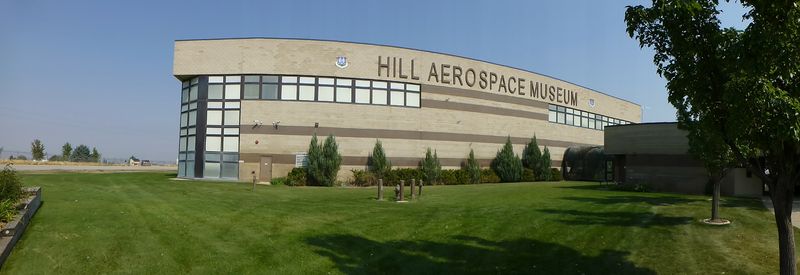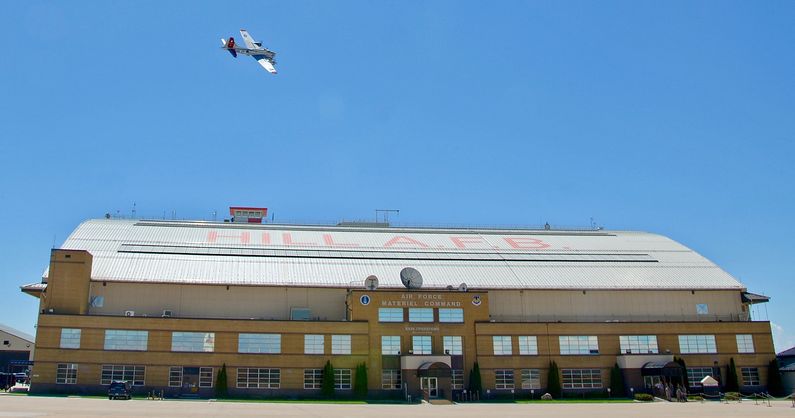Hill Air Force Base
|
Pre World War II(Text adapted from USAF Fact Sheet) In July 1939, Congress appropriated $8.0 million for the establishment and construction of the Ogden Air Depot at Hill Field. The official ground breaking ceremonies for construction of permanent facilities on Hill Field occurred on 12 Jan 1940. On 7 Nov 1940, Colonel Morris Berman, became the first commanding officer of the Ogden Air Depot, marking the formal activation of the logistics and maintenance unit. World War II (1939-1945)The Ogden Air Depot strength grew to a World War II peak of over 20,000 personnel; this total included 15,780 civilians and about 6,000 military personnel. The depot had a renowned reputation for its repair and supply support for aircraft including the B17, B24, B26, P40, P47, A20, the AT11, and several widely used reciprocating engines. At the nearby Wendover Army Airfield range, scores of heavy bomber crews trained in air combat operations, and aircraft and munitions maintenance and supply. Crew members of the 509th Composite Group, for example, practiced bombing runs at the Wendover Range in preparation for the Hiroshima and Nagasaki missions that assisted in ending World War II. Post World War IIOn 18 Sept 1947, the Army Air Forces became the U.S. Air Force, independent from the U.S. Army. On 5 Feb 1948 Hill Field became Hill Air Force Base (AFB). After a succession of wartime name changes, the Ogden Air Depot became the Ogden Air Materiel Area in 1946, succeeded by the Ogden Air Logistics Center in 1974. Korean War (1950-1953)The Korean War hostilities began in June 1950. Hundreds of B26 and B29 aircraft, long stored at Hill AFB, were rapidly returned to combat readiness by the Air Depot for deployment to the Far East. Cold War (1947–1991)Following the termination of the Korean conflict in July 1953, the depot’s maintenance production lines continued operations with work on jet fighter aircraft including the F84, F89, F101 and F102. Hill AFB’s acreage doubled in size on 1 Apr 1955, when the Department of Defense transferred the adjacent U.S. Army Ogden Arsenal to the Air Force. That area is now the West Area of Hill AFB. The new acreage added more than 600 buildings and structures. In 1960, all Air Force munitions depot operations were consolidated at Hill AFB under the 2701st Airmunitions Wing. In 1959, the depot was assigned responsibility for management of the Minuteman Intercontinental Ballistic Missile (ICBM). Management and maintenance responsibilities for the F4 Phantom fighter followed in 1962 and the F16 Fighting Falcon came later in 1974. In 1982, the Ogden Air Logistics Center was designated as system program manager for the Peacekeeper ICBM. During this same time, the depot also began conducting a significant portion of the Department of Defense’s C130 Hercules maintenance workload. The Center’s responsibilities during this period included management of all of the Air Force’s landing gear, photographic equipment and training devices, including software. Post Cold WarThe Cold War ended in 1990 resulting in the closures of air depots at Sacramento and San Antonio. Hill AFB then assumed responsibility for the A10 Warthog maintenance and engineering support. In 1990 and 1991, the Ogden Air Logistics Center and Hill AFB’s tenant units supported Operation Desert Shield and Operation Desert Storm. Current StatusFrom just over 3,000 acres in 1939, Hill AFB has grown to encompass over 6,000 acres in both Davis and Weber Counties, with management of an additional 900,000 plus acres throughout Northern Utah and Nevada. Hill AFB is Utah’s leading singlesite employer, employing over 20,000 military and civilian personnel within the Ogden Air Logistics Complex, 75th Air Base Wing, 388th Fighter Wing, 419th Fighter Wing, and various other tenant organizations on Hill Air Force Base.  The excellent Hill Aerospace Museum is located on approximately 30 acres on the northwest corner of Hill Air Force Base, Utah, about five miles south of Ogden. The museum was founded in 1981 as a part of the United States Air Force Heritage Program and first opened in 1986. It moved to its current facility in 1991. Annually visited by around 180,000 visitors yearly, from every state and many foreign countries.
See Also: Sources:
Links: Visited: 7 Jul 2015
| ||||||
